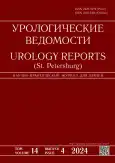Evaluation of the clinical effectiveness of transurethral bipolar surgery and laser technologies in treatment of patients with non-muscle-invasive bladder cancer
- 作者: Teodorovich O.V.1, Gameeva E.V.2, Suleymanov S.I.3,4, Shatokhin M.N.1, Borisenko G.G.1, Babkin A.S.1,4
-
隶属关系:
- Russian Medical Academy of Continuous Professional Education
- Federal Scientific and Clinical Center for Medical Rehabilitation and Balneology
- People’s Friendship University of Russia
- City Clinical Hospital No. 13
- 期: 卷 14, 编号 4 (2024)
- 页面: 373-380
- 栏目: Original articles
- URL: https://bakhtiniada.ru/uroved/article/view/287655
- DOI: https://doi.org/10.17816/uroved632520
- ID: 287655
如何引用文章
详细
BACKGROUND: Bladder cancer is the most common urinary tract cancer. Transurethral resection of the bladder wall tumor is the gold standard for non-muscle-invasive bladder cancer. In recent years, laser technologies have been actively implemented into clinical practice, including the surgical treatment of bladder cancer, but there are still many questions regarding their use.
AIM: To evaluate the efficacy and safety of bladder wall tumor resection followed by neodymium (Nd:YAG) laser ablation of the tumor.
MATERIALS AND METHODS: Surgical treatment outcomes in 97 patients with non-muscle-invasive bladder cancer were analyzed for the period between 2012 and 2023. Group 1 (n = 49) underwent classical transurethral resection of the bladder wall. Group 2 (n = 47) underwent the same procedure followed by Nd:YAG laser ablation of the tumor bed. Treatment outcomes were evaluated at 3, 6, and 12 months after surgery.
RESULTS: Analysis of complications using the Clavien–Dindo classification system showed a more favorable postoperative course in group 2. Within 1 year after surgery, the rate of bladder cancer recurrence was significantly lower in group 2 compared to group 1, with 4 and 13 cases, respectively (p < 0.05). In addition, no patient in group 2 had a recurrence in the area of the resected tumor bed, whereas 9 patients in group 1 had such recurrence during the specified period.
CONCLUSIONS: The study demonstrates the potential of using laser technologies in the treatment of bladder cancer. Its clinical implementation will facilitate personalized surgical treatment options for patients with urological cancers and reduce the risk of tumor recurrence.
作者简介
Oleg Teodorovich
Russian Medical Academy of Continuous Professional Education
编辑信件的主要联系方式.
Email: teoclinic@gmail.com
ORCID iD: 0000-0002-5145-0445
SPIN 代码: 1835-4808
MD, Dr. Sci. (Medicine), Professor
俄罗斯联邦, MoscowElena Gameeva
Federal Scientific and Clinical Center for Medical Rehabilitation and Balneology
Email: gameeva@yandex.ru
ORCID iD: 0000-0002-8509-4338
SPIN 代码: 9423-7155
MD, Dr. Sci. (Medicine)
俄罗斯联邦, MoscowSuleyman Suleymanov
People’s Friendship University of Russia; City Clinical Hospital No. 13
Email: s.i.suleymanov@mail.ru
ORCID iD: 0000-0002-0461-9885
SPIN 代码: 7168-8819
MD, Dr. Sci. (Medicine)
俄罗斯联邦, Moscow; MoscowMaxim Shatokhin
Russian Medical Academy of Continuous Professional Education
Email: sh.77@mail.ru
ORCID iD: 0000-0002-1285-7357
SPIN 代码: 7344-9309
MD, Dr. Sci. (Medicine)
俄罗斯联邦, MoscowGennadii Borisenko
Russian Medical Academy of Continuous Professional Education
Email: gborisenko-doc@mail.ru
MD, Cand. Sci. (Medicine)
俄罗斯联邦, MoscowAleksander Babkin
Russian Medical Academy of Continuous Professional Education; City Clinical Hospital No. 13
Email: alexbabkin3004@mail.ru
ORCID iD: 0000-0003-1570-1793
SPIN 代码: 3442-3309
俄罗斯联邦, Moscow; Moscow
参考
- Bray F, Ferlay J, Soerjomataram I, et al. Global cancer statistics 2018: GLOBOCAN estimates of incidence and mortality worldwide for 36 cancers in 185 countries. CA Cancer J Clin. 2018;68(6): 394–424. doi: 10.3322/caac.21492
- Kaprin AD, Starinsky VV, Shakhzadova AO. Malignant neoplasms in Russia in 2022 (morbidity and mortality). Moscow: P.A. Herzen MNIOI. 2023. 275 p. (In Russ.)
- Chavan S, Bray F, Lortet-Tieulent J, et al. International variations in bladder cancer incidence and mortality. Eur Urol. 2014;66(1):59–73. doi: 10.1016/j.eururo.2013.10.001
- Hinotsu S, Akaza H, Miki T, et al. Bladder cancer develops 6 years earlier in current smokers: analysis of bladder cancer registry data collected by the cancer registration committee of the Japanese Urological Association. Int J Urol. 2009;16(1):64–69. doi: 10.1111/j.1442-2042.2008.02194.x
- Miyazaki J, Nishiyama H. Epidemiology of urothelial carcinoma. Int J Urol. 2017;24(10):730–734. doi: 10.1111/iju.13376
- Burger M, Catto JW, Dalbagni G, et al. Epidemiology and risk factors of urothelial bladder cancer. Eur Urol. 2013;63(2):234–241. doi: 10.1016/j.eururo.2012.07.033
- DeGeorge KC, Holt HR, Hodges SC. Bladder cancer: diagnosis and treatment. Am Fam Physician. 2017;96(8):507–514.
- Palou J, Pisano F, Sylvester R, et al. Recurrence, progression and cancer-specific mortality according to stage at re-TUR in T1G3 bladder cancer patients treated with BCG: not as bad as previously thought. World J Urol. 2018;36(10):1621–1627. doi: 10.1007/s00345-018-2299-2
- Babaevskaya DI, Taratkin MS, Enikeev DV, Olefir YuV. En bloc resection of bladder tumour: a new standard for treatment of non-muscleinvasive bladder cancer. Urology and Andrology. 2021;9(1):23–26. EDN: QCOEXV doi: 10.20953/2307-6631-2021-1-23-26
- Enikeev D, Babjuk M, Shpikina A, et al. En bloc resection for nonmuscle-invasive bladder cancer: selecting a proper laser. Curr Opin Urol. 2022;32(2):173–178. doi: 10.1097/MOU.0000000000000968
- Bai Y, Liu L, Yuan H, et al. Safety and efficacy of transurethral laser therapy for bladder cancer: a systematic review and meta-analysis. World J Surg Oncol. 2014;12:301. doi: 10.1186/1477-7819-12-301
- Teodorovich OV, Shatokhin MN, Abdullaev MI, et al. Interstitial laser coagulation in the management of urothelial papillary carcinoma of the renal pelvis. Urologiia. 2018;(4):122–126 EDN: YLVSHR doi: 10.18565/urology.2018.4.122-126
补充文件








